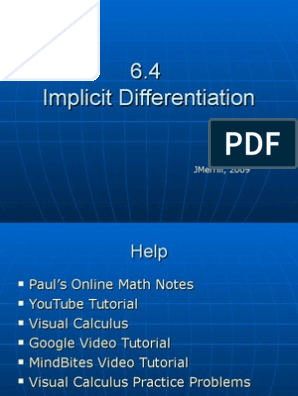0% found this document useful (0 votes)
46 views5 pagesModule 4
This document discusses differentiating implicit functions. The key points are:
1. Implicit functions are equations where the dependent variable (y) cannot be isolated as an explicit function of the independent variable (x).
2. Implicit functions can be differentiated using the "function of a function" rule: du/dx = (du/dy) * (dy/dx).
3. Products and quotients of implicit functions are differentiated using the product and quotient rules along with the "function of a function" rule.
4. Examples are provided of differentiating implicit functions involving sums, products, quotients, and multiple terms. The process involves taking the derivative of each term with respect to x.
Uploaded by
John Vincent VallenteCopyright
© © All Rights Reserved
We take content rights seriously. If you suspect this is your content, claim it here.
Available Formats
Download as PDF, TXT or read online on Scribd
0% found this document useful (0 votes)
46 views5 pagesModule 4
This document discusses differentiating implicit functions. The key points are:
1. Implicit functions are equations where the dependent variable (y) cannot be isolated as an explicit function of the independent variable (x).
2. Implicit functions can be differentiated using the "function of a function" rule: du/dx = (du/dy) * (dy/dx).
3. Products and quotients of implicit functions are differentiated using the product and quotient rules along with the "function of a function" rule.
4. Examples are provided of differentiating implicit functions involving sums, products, quotients, and multiple terms. The process involves taking the derivative of each term with respect to x.
Uploaded by
John Vincent VallenteCopyright
© © All Rights Reserved
We take content rights seriously. If you suspect this is your content, claim it here.
Available Formats
Download as PDF, TXT or read online on Scribd
/ 5






























































































